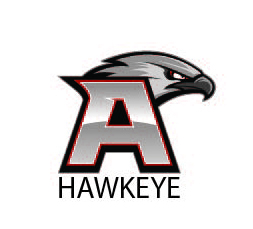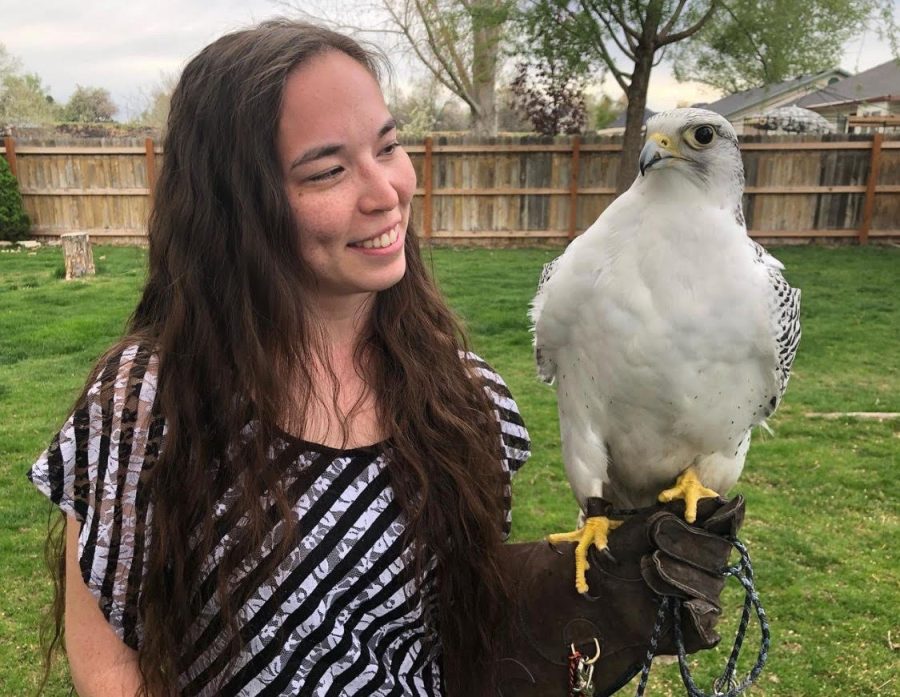Krista Edwards poses with a gyrfalcon, one of the more highly sought after birds of prey for falconry. These birds sell for $20-40,000.
Teacher Krista Edwards Finds Peace when Flying her Birds of Prey
Ms. Edwards's love for birds has fueled a lifelong passion to conserve and train raptors in a hobby called Falconry.
Being an Alta Hawk is a dream come true for English teacher Krista Edwards because she loves birds, especially birds of prey.
Edwards is a falconer! She has been interested in birds for as long as she can remember. She was always fascinated by birds, and finally started falconry as a hobby seven years ago. Since then, she has taken incredible journeys across the country and even the world, exploring, learning, and teaching.
Edwards loves to share her hobby with others, and brings her birds to school at times. Her students are not distracted by the birds that she brings. 9th grade student Bella Hansen said the birds do not disrupt class. “The birds actually help us finish our work faster,” she said.
Olivia Kinder added that when the class finishes their work, they can look at and talk about the birds. “The birds are more motivational than anything,” she said.
Having the birds in our classroom actually helps us finish our work faster. When we finish our assignments, we can look at and talk about the birds.
— Olivia Kinder and Bella Hansen, 9th grade
Edwards defined falconry as “the art of training a bird of prey to hunt alongside a human.” A falconer’s more modern role is being “involved in conservation of raptors and education.”
Evidence of falconry can be found as far back as 5,000 years! Falconry was originally used as a way to hunt prey, and emerged all over the eastern world in China, India, Africa, and the Middle East.
The practice gradually moved west to Greece, Italy, and eventually Europe. In the 6th to 13th centuries, falconry evolved from a hunting practice to a sport that mostly royals practiced. Training and keeping birds of prey became a status symbol. By the 1800’s, the sport grew less and less popular as other ways of hunting were developed.
Today, it’s an expensive hobby to start. Edwards estimated that the start up cost can be “anywhere from $2,000 to 5,000, and each year it’s around $1,000 to 2,000 to feed the birds.”
To practice falconry, you need to have a permit, and you need a separate permit to take and train birds from the wild. The easier route is to just buy birds, but many cost thousands of dollars, especially if they already have some basic training. Some of Ms. Edwards’s birds are rescues. Her kestrel falcon, Killian, is blind in one eye and cannot return to the wild.
“Some falconers do share their birds, but usually one bird goes with one falconer.” Edwards shares her birds “because I like them to be socialized with other people. That way, I can bring them to school and it’s not a big deal for the birds.”
The people that are in it all form a bond that is more than just friendship. It’s like family.
— Krista Edwards
Edwards likes to name her birds after literary works. However, some falconers don’t name their birds because “Falconry is so dangerous. There’s a huge risk that the birds fly away or get eaten, and people don’t want to get too attached. I name my birds because they are part of my family,” Edwards said.
Edwards has found many friends through this hobby. She said “The people that are in it all form a bond that is more than just friendship. It’s like family. We are joined together by a love for the wild and for working with wild animals.”
One of Ms. Edwards’s more unique experiences was going to Spain on the invitation of the King of Spain’s royal falconer. He had invited her to participate in the sport. She has also been invited by the King of Saudi Arabia, but has yet to go. “It’s such a small community,” she said, “Everyone has heard of each other.”
Edwards does photography along with falconry and and posts the photos, which was how people find her. “I’ve had the fortune to meet many influential people,” she said.
Edwards loves this hobby. “It’s an extremely rewarding lifestyle,” she said. “Working with birds and seeing their different personalities is only a fraction of falconry. The people in the community make it a much more gratifying hobby to participate in.”

